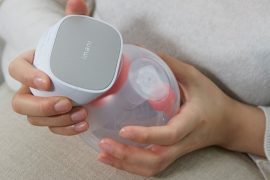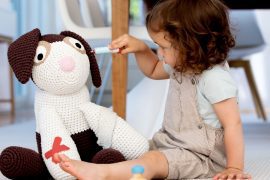By Emma Pickett
Two mothers have flat nipples.
One, in her first conversation about breastfeeding antenatally, was told by a health professional looking at her nipples, “You won’t get any milk out of those!”
The second was told by a breastfeeding counsellor when pregnant, “It’s called breastfeeding, not nipple-feeding. The shape of your nipples have nothing to do with breastfeeding. You’ve got nothing to worry about.”
I’m guessing that the first story gives you a horrible sinking feeling and the second story feels more comfortable but in fact, both mothers feel a sense of resentment when they look back at those early conversations.
In both cases, they feel they were let down. Those conversations haunt them.
I do wince a little when I hear someone trot out, “it’s called breastfeeding, not nipple-feeding,” because it’s not always that easy. We live in a world where so many breastfeeding resources show prominent obvious nipples. If you are preparing antenatally, and you have flat nipples, you will struggle to find a video that shows someone who looks like you. If you are worried about your nipple shape in pregnancy, you need to have a conversation with someone who listens to those worries, talks you through what’s going to happen in detail and will stand alongside you.
Simply saying, “it’s called breastfeeding, not nipple-feeding” is the equivalent of saying, “Don’t worry,” and leaving it at that. More information needs to come next.
Truthfully, flat nipples do bring some challenges. It is unfair to say that it won’t matter. It is unfair to suggest that you might not need some extra support. It DOES NOT MEAN that breastfeeding won’t be positive and successful and you won’t reach your breastfeeding, goals but you may need to take more time to find out who is going to help you out in the early days. You may have less wiggle room when it comes to getting positioning and attachment off to a good start.
Babies start to breastfeed when their sucking reflex is triggered. As the name ‘reflex’ implies, this isn’t about a baby choosing to breastfeed, it’s an involuntary process. When the roof of the baby’s mouth is touched, the baby will start to suck. A nipple with some length touching the roof of a baby’s mouth is likely to be a shortcut to getting a feed off to an easier start. If the nipple is flat or if the baby has a high palate, or if both is true, that connection may not be as straightforward. Nor if a baby has issues with tongue function that may make it difficult for them to scoop breast tissue deep inside their mouth and into position. If the nipple is not going to be making easy contact, the baby will need a deep mouthful of breast and to take breast tissue back far towards their hard palate.
Here is Annabel’s story: “I asked the midwife when I was pregnant with my first whether flat nipples would cause a problem and she said no, so I didn’t work out a game plan. I still remember looking at my nipples in my tongue-tied baby post-birth and this sinking realisation that they looked like pieces from two very different jigsaw puzzles. It would’ve been so much more helpful to be prepared that it might take us a bit longer to work it all out and to learn all the things we could do in the meantime. For us, that would be: the three keeps, Latch Assist [a product that temporarily extends nipple shape with suction], trying to feed as soon as the baby stirred. Second tongue-tied baby last year and nipples were back to flat. The physical bits were if anything harder but emotionally a whole different experience as I was prepared and had the confidence from feeding my first till two – wish you could bottle that!”
In a conversation about flat nipples on Twitter, Gill Rapley, author of ‘Baby-led Breastfeeding,’ posted, “if the nipple is short, flat or inverted, baby needs to take more of the breast.” It’s a simple message. Once there is contact on the roof of baby’s mouth, just a few millimetres of further movement, that reflex will be triggered. So, these are times to ensure that everyone really understands getting a deep latch is important. Every millimetre counts. We can’t afford to lose them with baby’s hands at their chest, bunched up clothing, the chin not in good contact with the breast or a neck twist.
If a baby can’t move their head flexibly and tilt back, the chances of their tongue and chin being where they need to be become more remote.
What are some of the principles we will be talking about after the, “it’s not called nipple-feeding” comment?
1. Talking about getting a deep latch (Have I mentioned that yet?)
In times when it may be harder to see a lot of breastfeeding in real life, videos matter even more. Global Health Media’s ‘Attaching your baby at the breast‘ is a staple. Their ‘Early Initiation of Breastfeeding‘ is useful here as around 7 minutes, you’ll see a baby doing a breast crawl and self-attaching to a flat nipple. It’s important that babies are anchored and secure, but able to move their heads freely. A baby that is dangling under the breast and not feeling supported is going to struggle to bring their tongue to the right place and scoop breast tissue where it needs to be. If someone is battling their baby’s hands, that’s a clue that baby may benefit from being more prone so the hands are no longer the enemy. We want to avoid positions where gravity is making life harder, when it could be making life easier.
In her article, ‘Many moms have been taught to breastfeeding incorrectly’, Nancy Mohrbacher talks through how body positioning impacts on a cascade of behaviours from baby. We want a baby to be able to do what it needs to do, not fighting against a breastfeeding pillow at the wrong height, balancing on a couple of fingers or under a mother who is leaning forward to breastfeed. Nor dealing with a breast that has been pulled over and then inevitably springs back to its natural position when a hand is removed. Nancy Mohrbacher’s videos on natural breastfeeding can help.
2. Talk about minimising engorgement
Engorgement is the enemy of those with flat nipples. We joke about how a baby latching on to an engorged breast is like trying to get onto a bowling ball, but when you have flat nipples, engorgement is scary. We need baby to get a mouthful of breast tissue and we need the breast tissue to be flexible. If the baby can’t move the breast tissue to the roof of their mouth, it could be challenging. And that’s on top of all the other challenges that engorgement can bring, like an inhibited letdown reflex and discomfort. We want regular feeding to be happening in those early days. If anyone on the planet is still saying, “Don’t wake a sleeping baby”, let’s hope they aren’t talking to someone with flat nipples. We want to talk about reverse pressure softening, using cool compresses to reduce fluid in the breast and some hand expression before a feed.











